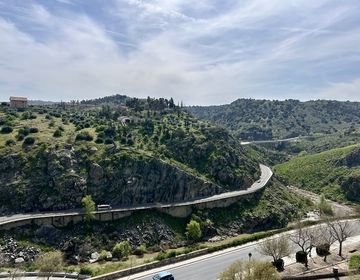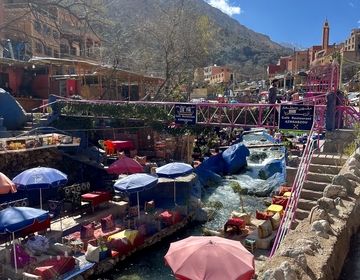Fun Can Always Be Free
Last weekend was a fun example of how you can do so many wonderful things in Madrid for free!
We made a plato of delicious rice (ingredients had already been purchased, no money spent) and packed it in a tupperware for a picnic in Casa de Campo. I figured it’d be fun to take the metro to a stop near the park that I’d never been to before and just see what we could find. We got off and found tons of restaurants surrounding a (dried up) lake. It looked beautiful. We’ll definitely return when it’s warmer.
Just a bit further in we found a lovely picnic spot atop a hill with views overlooking rows and rows of trees. Casa de Campo is a magical mystery. You never know what kind of landscape you’ll encounter, and you’re always bound to be pleasantly surprised. We ate at a wooden picnic table while a family played soccer nearby.
After eating, we wandered up and over hills and on dirt roads until we found space to play frisbee. It was nice to get in some kind of physical activity in a wide open space in a city. The field was beautifully lit just before sundown. The sun cut through the trees yielding lines of light and lines of less light alternating on the ground. How fulfilling it is to be amongst natural beauty! (Insert appropriate Walt Whitman quote here).
We exited Casa de Campo at a spot that would lead us to a special church in Madrid. I had been there once before with a class during my semester here a few years ago. Francisco de Goya--one of Spain’s most beloved and well-known painter--painted the frescoes that decorate the walls and ceiling of San Antonio de la Florida. The imagery is dedicated to the story of a man who came back from the dead in order to clear the name of his father who had been wrongly accused of murdering him. It’s a wild story with a wild depiction; Goya includes all sorts of madrileño social types (specifically, ones that San Antonio is supposed to represent) in the crowds witnessing the event, mixing the modern with the traditional (I’ll be giving a presentation on Goya this week, more on that to come…). The main event of the story is situated around the inside of the dome at the top of the church. The entire scene takes place behind a fence that circles around with the dome.
One major part of the church is how the city has gone about conserving the artwork. According to a plaque in the church, the building was bombed during the Spanish Civil War, and serious restoration was needed. At some point, whoever was in charge of the church did not take care of the frescoes, and so more restoration was needed. Now the pamphlet at the entrance to the church makes a point of noting that the frescoes are being taken care of, and stands with information in the corners of the church have photographs of what that entails (fixing up some cracks, not being able to fix up other cracks, etc.).
I must say, one of the most fun parts of the visit was the statue of Goya across the street from the church. Erected in the 1980s, it is in perfect condition, unlike so many other statues wanderers come across in historic places. The dedication on the statue is legible and at eye-level. Goya sits in a chair, brush and palette in hand. It’s puzzlingly placed on a street with not much pedestrian-traffic, but I’m sure that statue is in tons of selfies (if the large tour bus next to it was any indication…). Of course, I got my picture too!
Related Posts
Day Trip to Toledo, Spain
If you’re looking to explore more of Spain outside of Madrid, the beautiful city of Toledo is the perfect day trip. A quick 50 minute bus ride will drop you... keep reading
Working at the Secondary Level
When choosing an age group to work with, I think it’s common to choose to work with the younger students because they are perceived as more fun or “easier to... keep reading
How To: Smart Solo Travel Tips
Traveling alone in Europe is an incredible experience—whether you're wandering through historic cities, relaxing in cozy cafés, or discovering hidden gems off the beaten path. Solo travel allows you to... keep reading


